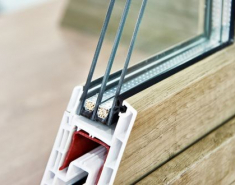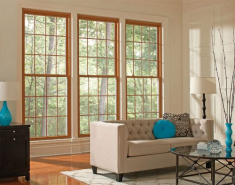Window Design: 7 styles suited for a modern home
They say eyes are the windows to a soul, so then what exactly are windows to a house? There is no debating the importance of windows in any given building—not only do they serve functional purposes such as introducing daylight and ventilation to an indoor space, but they also add character and architectural detail to a structure.
Windows can completely alter the look and feel of a room and of course, they are one of the key factors that determine the facade of your house. Here’s a look at 7 different window designs.
Clerestory
A clerestory window is typically a single set or a series of windows that are positioned way above the eye-level. These are usually found at the top of the wall, near or at the junction where the wall and roof meet. Even though this style of window is not modern, in fact, they were found in temples of ancient Egypt, they sit very well in the design of a modern home which has large indoor spaces. These windows flood the interior space with natural light and give a lofty feel to any room.
Best suited for: Kitchen, library, atriums, bathrooms, basement.
Pros: When the windows are placed higher up you get more open wall space to add curios or art.
Cons: During summer, these windows may cause an unexpected glare or overheating because of the angle at which the sunlight enters the room.
Awning
This style of window is hinged at the top and opens outwards from the bottom. Deriving its name from a roof-like cover usually placed over the window frames, this window, too, provides shelter from the rain while not blocking either the light or the ventilation. They are mostly used in combination with other fixed windows and in spaces where the width of the window is greater than its height.
Best suited for: Kitchen, bathrooms, sunroom.
Pros: Awning windows allow for unobstructed views of the outdoors, since the sash (or the frame of the window) is only around the glass and not in the middle, in case of say, a casement window.
Cons: Unless installed on the ground floor, cleaning of the outside of the awning window can be a bother.
Skylight
As the name suggests, these windows are installed in the roofline to let in a sort of a day spotlight into a room. Usually, these windows are fixed, but some people do prefer to have ones that they can open and close for ventilation. They are a great source of natural light in rooms such as an attic, which do not have sufficient height for placing regular windows.
Best suited for: Attics, bathrooms, atrium.
Pros: This kind of window is perfect for row-houses that do not have windows on either side of the house.
Cons: Skylight windows are exposed to natural elements such as rain, hail, harsh sunshine and strong winds and as such require quite a bit of maintenance. Covering it from the inside is cumbersome.
Bay window
Bay windows are a set of windows that extend outwards from an exterior wall. These typically consist of one stationary window in the middle which is flanked on either side by casement windows (regular windows that are hinged at the side and open outwards). Bay windows are more rectangular and boxy in their shape, whereas their curvy counterparts are called bow windows. These stylish windows provide an excellent view of the outdoors and also flood the indoor space with natural light.
Best suited for: Living room, master bedroom, parlours.
Pros: The additional interior space provided by this style of windows can easily be used as a reading nook, or as a greenhouse space for indoor plants.
Cons: Expensive to install and they may cause overheating if not properly glazed or curtained.
Crittall
Technically, only windows made by Crittall Windows Ltd can be called Crittall windows, but over the years the term has been generously used to describe a black steel-framed window. Crittall windows have been around since the late 1800s, but they have never gone out of style. The steel and glass give these windows a very industrial-chic look and are perfect for a modern home. These windows are often used as room partitions,or installed in exterior walls facing the garden or the backyard.
Best suited for: Living room, room partitions, exterior wall of a stairwell.
Pros: Easy to clean and with the correct treatment, the steel frames will last you a long time.
Cons: Cannot replace a good, solid wall.
Hopper
Hopper windows are similar to awning windows except that they are mostly hinged at the bottom and open inwards from the top. These kinds of windows are perfect for small, tight spaces that require ventilation apart from natural light. You can also install them on walls that do not have any space for a window to open outward. Since hopper windows do not open all the way inside, these are fairly secure windows, but on the other hand, these can never be used as an escape during an emergency.
Best suited for: Basements, bathrooms, kitchen.
Pros: Since hopper windows open inwards, these are one of the easiest windows to clean from both sides.
Cons: They gather a lot of dust and debris and need to be cleaned often. Not easy to cover with blinds or curtains.
Glass Block
True to their name, glass block windows are fixed windows made of thick, semi-opaque glass blocks that are mortared into walls or installation spots. The main highlight of such a window is to let the light pass through while ensuring privacy at the same time. Since they serve more of a utilitarian purpose than a decorative one, they are not often seen in homes. But with the right vision and implementation, these windows can completely transform the look of a particular space.
Best suited for: Bathrooms, basements, bar units, open kitchen.
Pros: These windows are highly durable and won’t require replacement or repair for years after installation.
Cons: Made up entirely of blocks of glass or acrylic, they are very heavy and require you to be absolutely sure of their integration in your house.
Source: https://bit.ly/35UwCl9









